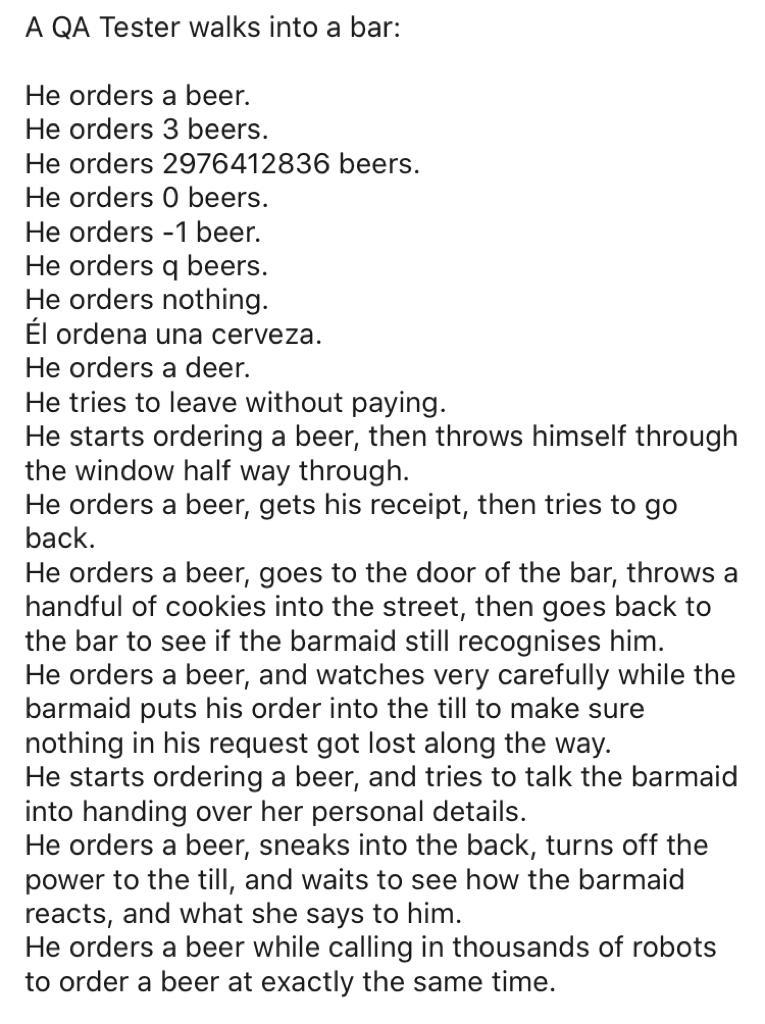A senior tester’s guide to surviving the velocity apocalypse with your sanity (and code quality) intact
The craft of software development has always shared a curious kinship with brewing beer. Both require patience, precision, and an understanding that rushing the process leads to something nobody wants to consume. Yet here we are in 2025, watching development teams chug AI-generated code like it’s happy hour at a startup, while QA teams get treated like the designated driver nobody invited to the party.
We killed QA because we thought we were clever. “Developers own quality,” they said. “Everyone is responsible for testing,” they chanted. “AI will make everything perfect,” they proclaimed. All nice slogans. All spectacularly wrong. And now, with AI tools like GitHub Copilot cranking out code faster than a German brewmaster during Oktoberfest, we’re about to discover what happens when you combine unlimited velocity with zero quality control.
The Vanishing Act: How We Ghosted Our Quality Control
I’ve been in this industry long enough to remember when every decent-sized engineering team had a proper QA department. Real testers. People whose entire job was to break your software in ways that would make a chaos engineer weep. These weren’t just glorified button-clickers—they were digital demolition experts who thought like the world’s most creative saboteurs.
Then the “Agile Revolution” arrived with its velocity mantras and continuous everything. Suddenly, QA became the scapegoat for every delayed sprint. Too slow. Too expensive. Too waterfall. So we phased them out, convinced that developers could test their own code and automation frameworks would catch everything else.
The results? About as predictable as a hangover after beer-testing night:
- Developers writing happy-path unit tests for code they’re emotionally attached to
- Test automation frameworks more brittle than day-old pretzels
- Customers reporting obvious bugs faster than you can say “hotfix”
- Executives asking the eternal question: “How on earth did this ship?”

AI Development Tools: Productivity vs Quality Trade-offs in 2025
Enter AI: The Velocity Amplifier That Breaks Everything Faster
Just when we thought we’d reached peak chaos, artificial intelligence crashed the party like an over-caffeinated intern with admin privileges. AI-powered development tools promise to revolutionize coding with the subtlety of a beer truck through a craft brewery.
The numbers are intoxicating: GitHub Copilot users report productivity increases of up to 53.2%, while 78% of developers claim overall productivity gains from AI tools. ChatGPT achieves 65% correctness on coding benchmarks, and developers are cranking out features faster than ever before.
But here’s the foam in your beer: AI accelerates code creation, not code quality. According to recent research, while 59% of developers say AI has improved code quality, a concerning 25% report that one in five AI suggestions contains factual or functional errors. When AI multiplies developer output by 2.8x but increases technical debt by over 200%, we’re not building software—we’re brewing a disaster.

Humorous tweet illustrating the complex, edge-case testing mindset of QA engineers contrasted with unexpected real-world failures.
The Developer Delusion: Why Coders Make Terrible Testers
Here’s the uncomfortable truth that makes developers squirm like they just tasted a skunked IPA: developers are fundamentally bad at testing their own code. Not because they’re incompetent—they’re brilliant at what they do. But asking a developer to thoroughly test their own creation is like asking a brewmaster to objectively critique their own recipe while drunk on their own product.
Developers are builders by nature. They’re wired to construct, to create, to make things work. QA professionals, on the other hand, are digital deconstructionists—they’re trained to think adversarially, to question assumptions, and to probe every edge case like they’re hunting for buried treasure.
Consider this: developers don’t naturally think, “What happens when someone pastes a 257-character emoji string into this field while simultaneously uploading a corrupted file during a network timeout?” But a good QA engineer? That’s Tuesday morning coffee material.
AI doesn’t magically develop this adversarial mindset either. Current AI tools are pattern-matching engines trained on existing code—they excel at generating more of what already exists, not at challenging the fundamental assumptions that code makes. When 65% of developers report missing context as the primary issue with AI-generated code, we’re essentially asking AI to fill in the blanks while blindfolded.
The Broken Windows of Software Development
The software entropy phenomenon—where code quality naturally degrades over time—isn’t just theoretical mumbo jumbo. It’s the inevitable result of accumulated technical debt, rushed implementations, and what security experts call the “broken windows theory” applied to codebases.
Every shortcuts taken, every “quick fix” that becomes permanent, every piece of undocumented AI-generated code contributes to what researchers term software rot. The data shows that without dedicated QA oversight, software systems experience accelerated quality decay, with customer-reported issues increasing by 1,600% and technical debt scores rising 324% compared to teams with proper quality assurance.

Software Quality Decay: The Critical Role of QA in Preventing Entropy
The AI Amplification Effect: Pouring Gasoline on Technical Debt
AI development tools don’t just speed up coding—they supercharge every existing quality problem. When teams already struggle with insufficient testing practices, AI becomes an accelerant that turns smoldering technical debt into a five-alarm fire.
Research from enterprise organizations shows that AI-accelerated development without proper QA oversight results in:
- Post-release issues increasing 16x compared to QA-supervised development
- Technical debt accumulation 324% higher than baseline development practices
- Customer satisfaction scores dropping 40% despite faster delivery times
The cruel irony is that AI could be the perfect complement to human QA—but only if we stop treating quality assurance as an optional luxury. Teams that combine AI acceleration with dedicated QA professionals achieve the holy grail: 80% faster development with 87% bug detection rates and maintained customer satisfaction scores above 8.0.
The Real-World Reality Check
Would you board an airplane where Boeing engineers announced: “Don’t worry, AI wrote the flight software and we tested it ourselves—QA just slows down our release cycles”? Would you trust medical device software where the development team proudly declared they’d eliminated those “bottleneck” testers in favor of pure AI-driven development?
Software now powers everything from autonomous vehicles to medical devices, from financial systems to critical infrastructure. When bugs don’t just cause user frustration but can literally destroy trust, cost fortunes, and risk lives, treating QA as optional isn’t just foolish—it’s criminally negligent.
Yet somehow, in our industry, we’ve convinced ourselves that software quality is a nice-to-have rather than a fundamental requirement.
Why Modern Software Feels Like Cheap Beer
If you’ve noticed that contemporary software feels increasingly buggy, unreliable, and disposable compared to applications from a decade ago, congratulations—you’ve identified the quality entropy in action. We’ve systematically dismantled the discipline of quality assurance and replaced it with wishful thinking and automation theater.
The shift-left testing movement, while well-intentioned, has become a convenient excuse to eliminate dedicated QA roles. “Everyone owns quality” sounds progressive until you realize it means nobody actually owns quality. It’s like saying everyone on a brewery floor is responsible for quality control—technically true, but you still need dedicated quality assurance professionals who understand the science behind what makes beer (or software) genuinely good.

Humorous description of a QA tester exploring edge cases through exaggerated bar orders, illustrating the mindset of thorough testing.
The Path Forward: Brewing Better Software Through Balanced QA
The solution isn’t to abandon AI or return to waterfall methodologies. It’s to recognize that AI without QA is just faster chaos. Here’s what actually works:
Embed QA Throughout Development
Modern QA isn’t about testing at the end—it’s about quality engineering embedded from requirements through deployment. QA professionals should be present in planning meetings, sprint reviews, and architecture decisions, acting as quality advocates rather than post-development inspectors.
Leverage AI to Enhance, Not Replace, Human Judgment
The most successful teams use AI tools to augment QA capabilities rather than eliminate human testers. AI excels at test case generation, regression testing, and identifying patterns—but humans remain essential for exploratory testing, usability evaluation, and understanding the business context that AI currently cannot grasp.
Implement Quality-First Metrics
Track defect density (aim for <1 defect per 1,000 lines of code), mean time to detect issues (under 24 hours), and customer-reported problems (under 0.5 issues per 1,000 active users monthly). These metrics reveal whether your development velocity is actually delivering value or just generating technical debt faster.
Create Sustainable Feedback Loops
Establish processes where QA findings directly influence development practices, AI tool configuration, and architectural decisions. When QA discovers that AI-generated code consistently fails specific edge cases, feed that information back to improve prompting strategies and validation processes.
The Bottom Line: Quality is Not Negotiable
This perspective will undoubtedly annoy the “shift-left + AI fixes everything” crowd. Good. That’s precisely the point.
Software development has never been just about writing code faster—it’s about creating reliable, maintainable systems that serve real human needs. When we eliminate dedicated QA in pursuit of velocity, we’re not building better software—we’re just shipping broken code more efficiently.
AI represents an incredible opportunity to revolutionize software development, but only if we pair its raw power with the disciplined craft of quality assurance. Without QA, AI doesn’t just accelerate development—it accelerates decay.
The choice is ours: we can continue down this path of velocity-obsessed development and watch software quality collapse under its own accelerated weight, or we can embrace the discipline that makes great software possible. Just like great beer, great software requires both innovation and quality control—rush either one, and you end up with something nobody wants to consume.
For our fellow engineers: Is AI our chance to rethink how we approach quality assurance, or are we doomed to ship broken code faster than ever before? The answer depends entirely on whether we’re brave enough to bring QA back from the dead—before our software quality follows the same path.
Cheers to building software that doesn’t suck, A battle-tested tester who’s seen it all
P.S. – Next time you’re debugging AI-generated code at 2 AM, remember: there’s probably a former QA engineer somewhere saying “I told you so” over a well-deserved beer.
